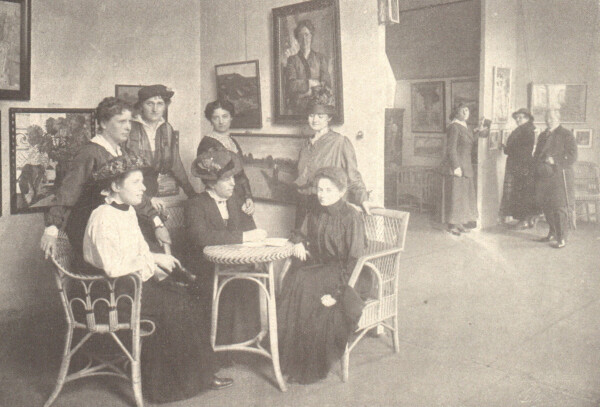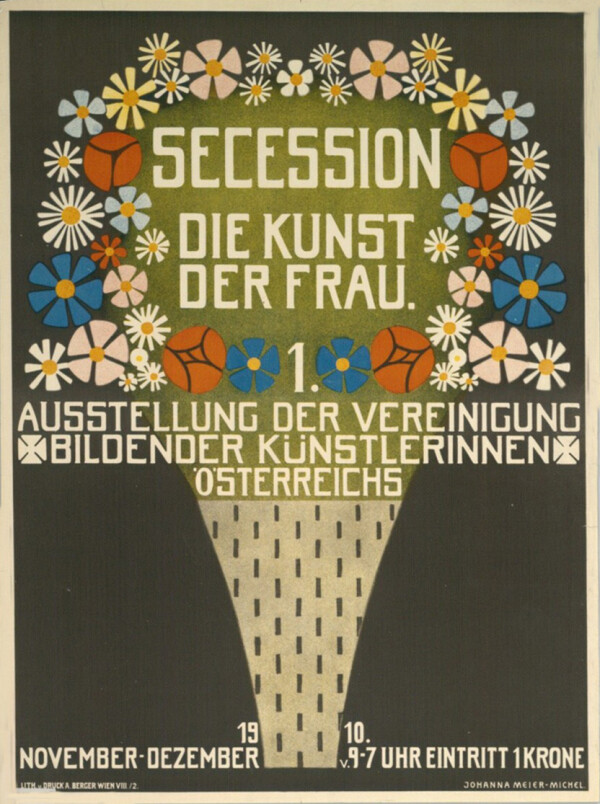Association of Austrian Women Artists

Members of the Association of Austrian Women Artists, in: Sport und Salon. Illustrirte Zeitschrift für die vornehme Welt, 22.04.1916.
© ANNO | Austrian National Library
The Vereinigung bildender Künstlerinnen Österreich – VBKÖ [Association of Austrian Women Artists] was founded in 1910 und is considered Austria’s first association of female artists. Their first self-conceived exhibition, entitled “Die Kunst der Frau” [“The Art of Women”], was a retrospective of women’s accomplishments in the visual arts that took place at the Vienna Secession in 1910/11.
In February 1910, the Association of Austrian Women Artists was established with the goal of giving women more presence and recognition on the male-dominated art scene and of legitimizing and promoting them. Just one month later, Olga Brand-Krieghammer, the association’s first president, successfully negotiated with the Association of Austrian Artists Secession on organizing an international art show that was to present a comprehensive “historical review of women’s achievements in art” on the premises of the Vienna Secession.

Johanna Meier-Michel: Poster of the XXXVII Secession Exhibition, Die Kunst der Frau, 1910, The Albertina Museum, Vienna
© The ALBERTINA Museum, Vienna
“The Art of Women”
The Vienna Secession, supporting the endeavor, eventually made its venue available to the young association from late fall 1910 for its retrospective “The Art of Women.” On this occasion, the association of women artists and the Secessionists published a comprehensive exhibition catalog entitled “XXXVII. Ausstellung der Vereinigung bildender Künstler Österreichs Secession, Wien – I. Ausstellung der Vereinigung bildender Künstlerinnen Österreichs. Die Kunst der Frau” [“37th Exhibition of the Association of Austrian Artists Secession, Vienna – 1st Exhibition of the Association auf Austrian Women Artists. The Art of Women”].
The show opened in early November in the presence of Archduke Rainer, under whose auspices the event took place. This collective exhibition, which was subsidized by the Imperial-Royal Ministry of Education, among others, comprised works by national and international female artists, as well as numerous loans from public collections and private galleries throughout Europe. The exhibition, which already closed in January 1911 and had an attendance of more than 13,000, was reviewed differently in the Austrian media. Whereas the traditional and conservative press severely criticized the event, particularly women’s magazines published quite positive reviews – for example Der Bund – Zentralblatt österreichischer Frauenvereine:
“All in all, it has to be said that this first exhibition of Austria’s women artists has been a great success and is a fine promise for the future; that it has shown a great deal of honest ambition and proficient skills; that the women have extorted respect for their achievements.”
Internal Split-Offs and Continuity
In 1912 the association of women artists finally moved into its own headquarters at the Hotel Astoria on Maysedergasse in Vienna’s First District, continuing its annual exhibition program at the Hagenbund and the Künstlerhaus, among other venues. After World War I, several internal splinter groups formed, with a number of relatively short-lived associations establishing themselves, such as the Freie Vereinigung [Free Union] or Wiener Frauenkunst [Viennese Women Art]. However, the Association of Austrian Women Artists continued to exist and even persisted during the regime of National Socialism and World War II, which also entailed structural changes and questionable decisions. Today the VBKÖ, which has openly dealt with its ambivalent past since the 1990s, positions itself as an open-minded organization looking into and promoting contemporary feminist and artistic matters.
Literature and sources
- ÖNB. Ariadne. www.fraueninbewegung.onb.ac.at/VBKOE (04/06/2020).
- Vereinigung bildender Künstlerinnen Österreichs. VBKÖ. www.vbkoe.org/geschichte (04/06/2020).
- Vereinigung bildender Künstlerinnen Österreichs. Archiv. www.vbkoe.org/das-vbkoe-archiv/ (04/06/2020).
- Helene Littmann: Die Kunst der Frau, in: Österreichische Frauenrundschau. Mitteilungen der Vereinigung der arbeitenden Frauen, 01.12.1910, S. 2-3.
- Leopoldine Kulka: Die Kunst der Frau, in: Neues Frauenleben, Heft 12 (1910), S. 11-13.
- Der Morgen. Wiener Montagblatt, 06.06.1910, S. 9.
- Die Kunst für Alle. Malerei, Plastik, Graphik, Architektur, 26. Jg. (1910/11), S. 193-202.
- Der Bund. Zentralblatt des Bundes österreichischer Frauenvereine, 5. Jg., Heft 7 (1910), S. 9-11.
- Vereinigung bildender Künstlerinnen Österreichs (Hg.): Jahresbericht der Vereinigung bildender Künstlerinnen Österreichs für das Vereinsjahr 1910, Vienna 1911.
- Vereinigung bildender Künstler Österreichs Secession (Hg.): XXXVII. Ausstellung der Vereinigung Bildender Künstler Österreichs Secession - I. Ausstellung der Vereinigung Bildender Künstlerinnen Oesterreichs. Die Kunst der Frau, Ausst.-Kat., Secession (Vienna), 05.11.1910–08.01.1911, Vienna 1910.

